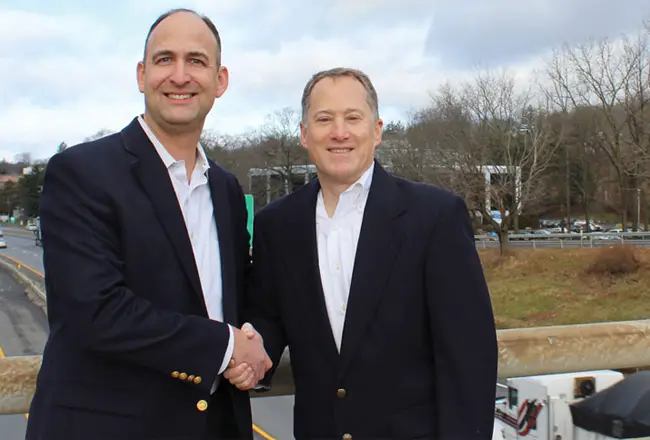Tarrytown’s Carrier Logistics helps trucking companies keep up with demands of digital economy
Pick any object and, odds are, it came off a truck.
As Carrier Logistics Inc. President Ben Wiesen puts it, “everything we interact with, from the pen that you”™re holding, to the table we are sitting around, got moved from its point of manufacture to the point we are using it. And it was moved on a truck.”
The Tarrytown-based company may well have had a role in moving that product. Carrier Logistics has been in the trucking industry for more than 40 years, despite not owning any trucks nor employing any drivers. Instead, the company provides software and logistics consulting to help trucking companies run more efficiently.
Wiesen stepped in to the leadership role of the company in December, along with Kevin Linardic, who was named chief technology officer the same week. They met with the Business Journal at Carrier”™s office on White Plains Road to discuss the evolving nature of the trucking industry and what it means for the company.

“The leaders in trucking aren”™t the men and women with the most grease under the fingernails,” Wiesen told the Business Journal. “It”™s the folks who are looking at trucking as a business, and they are measuring trends and performance indicators and demanding more information.”
Since 1972, Carrier Logistics has been working to supply that information. The company”™s focus from the start was applying technology to what was at the time a nontechnological industry.
Founders Don Adams and Ken Weinberg initially focused on taking “error-prone manual processes and automating them,” Wiesen said.
“When you think about what a trucking company does ”” servicing multiple customers on a route ”” what do they need to do?” Wiesen said. “They need to reduce miles, they need to make service commitments and they need to handle the freight through warehouses as efficiently as possible.”
Carrier Logistics developed its specialty doing consulting and engineering in the less-than-truckload sector, which is the sector of the industry that makes multiple stops while carrying smaller amounts of freight. That included helping those companies shift from phone books to computer databases. It may not sound revolutionary today, but it saved trucking companies time and money and helped reduce errors.
As the company”™s business grew, computers shrunk. They also became cheaper. As this happened, the vision of making technology accessible in the trucking industry became more realistic. By the 1990s, Carrier offered trucking companies a full planning and business management system.
The company has grown to 30 employees developing and supporting its software for the trucking industry. The company is focused mostly in the U.S. and Canada, but also works in Australia and the United Kingdom.
Trucking generated industrywide revenues of more than $700 billion in the U.S. last year, according to the American Trucking Association. Trucking companies moved 10.77 billon tons of freight and employed 7.7 million people.
Wiesen and Linardic both joined the company in 1995 and have seen the industry change rapidly over that time. Trucking companies are adapting their systems to be prepared for an economy driven by online shopping and quick delivery times.
“They have to be there when they are needed and get where they are needed on time and adjust very, very rapidly,” Wiesen said. “Orders are no longer placed months in advance based on very complicated scheduling predictions. Now, people push a button on their phone and expect product to be somewhere the next day.”
Carrier pitches its cloud-based software platform, called FACTS, as a way for trucking companies to thrive in that changing environment. Short for Freight Accounting and Tracking System, the company describes the software as a fully integrated system to handle each step of the shipping process from order to delivery: real-time quotes, route planning and tracking, billing and every other step of the delivery process.
The company”™s client mix, as described by Wiesen, includes small and growing companies, with fleets of 20 or so trucks, along with others operating fleets of more than 1,000 trucks positioned around the country. Wiesen said his company”™s platform can help “level the playing field” for providers competing with national carriers, who often invest substantial resources in developing internal logistics software.
Carrier is focused on introducing advanced technology, such as artificial intelligence and blockchain, to advance its platform. The company is asking “how can we seize these opportunities to optimize what warehouse workers are doing? To optimize the route the trucks run?” as Wiesen described it.
Artificial intelligence can run complex algorithms for dynamic route pricing.
Blockchain ”” essentially a shared digital ledger ”” can uncover errors in the shipping process. RFID technology ”” what is used in your E-ZPass ”” identifies and weighs freight from the second a forklift picks it up and directs which truck the operator needs to drop it on.
“In real time, the fleet operators know, OK, the Chicago freight was loaded on the Chicago truck,” Wiesen said.
Trucking is seen by many to be headed toward a driverless future. A headline in the Wall Street Journal last fall read “Self-Driving Technology Threatens Nearly 300,000 Trucking Jobs,” citing a new research paper. Wiesen said that while technology may already allow for companies to go driverless, “that is different from saying they should.”
Rather than fully driverless, Wiesen said trucking is more likely headed toward the use of autonomous fleets in the next three to seven years. That means one truck with a driver would guide a caravan of autonomous trailers down straight stretches of highway.
“We won”™t see that in a city environment,” Wiesen said. “But when you look at the United States, there are thousands of miles of straight road with limited entrances and exits. Those are the areas where you are going to see autonomous vehicles even though the technology could support a lot more.”